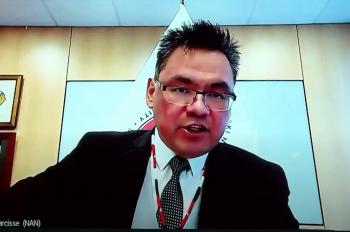Image Caption
Summary
Local Journalism Initiative Reporter
Windspeaker.com
Any final agreement from the federal government to reform the First Nations child and family welfare system must be adjusted to consider the actual costs of delivering equitable services in remote communities.
That’s the battle the Nishnawbe Aski Nation (NAN) started fighting when it gained intervener status in 2016 on the landmark human rights case launched in 2007 by the First Nations Child and Family Caring Society and the Assembly of First Nations when they challenged Canada’s discriminatory funding of First Nations family and child welfare services at the Canadian Human Rights Tribunal (CHRT).
And it’s a fight NAN is continuing, said Deputy Grand Chief Bobby Narcisse.
“For the first time, I’m very encouraged to say that this deal puts us on a path to quantifying and indexing remoteness on a national scale. For the first time, math and science will dictate the numbers: this is what it costs to deliver child and family services in our communities,” said Narcisse.
“This is what it’s actually going to cost to end the discrimination within our remote communities.”
Narcisse joined other First Nations leaders and federal ministers at the announcement of agreements-in-principle yesterday that will see $20 billion in compensation for children, families and caregivers who experienced the child welfare system and $20 billion for the reform of the system led by First Nations. He also held a separate news conference after the event.
The work undertaken by NAN to quantify the increased costs of service delivery in the north has been done through a remoteness quotient (RQ).
“So our work with RQ is an empirical mathematical exercise that just takes all these different economic areas and … (says) this is how much it would cost to provide equitable resources in our communities,” said Narcisse.
Although NAN started by representing its 49 northern Ontario First Nations, its voice has grown.
Under the agreement, NAN’s remoteness quotient work will take on a national scope. The deal recognizes the newly formed National Assembly of Remote Communities (NARC), which has brought together remote communities from Alberta, Saskatchewan, Manitoba, Northwest Territories and Ontario.
A Remoteness Secretariat will be established nationally to address barriers faced by remote Indigenous communities across the country and will assist First Nations with data collection, analysis, and other operational supports.
Narcisse said NAN had a bilateral process for negotiating with Indigenous Services Canada and “that work will remain separate and will be resourced properly” through a separate stream of funding and resources.
He said the same will happen when work moves ahead with NARC.
“Insofar as NAN has its own pathway moving forward with child and family services reform, we are also supporting a lot of the work that’s happening nationally as well with our partners across Canada with the NARC,” said Narcisse.
Including a specific stream of funding for northern and remote First Nations does not take away from the unique needs and challenges of the southern communities, said Narcisse, who will also be negotiating their needs with the government.
“But at the same time, too, we want to work with all of our partners within the agreement-in-principle process to ensure that all of our area sector discussions will be funded properly to ensure the work happens and the work is reflective of the community areas,” said Narcisse.
Work toward long-term reform will include AFN-facilitated engagement sessions to guide negotiations to ensure the reformed family and child welfare program is relevant and responsive to the needs of First Nations children and families across the country.
As for the other half of the total $40 billion settlement, Narcisse said NAN will work with its communities to ensure the responsible distribution of the $40,000 that each impacted child, youth and family members is entitled to.
He said lessons need to be learned from individual settlements that came as a result of the Indian residential schools, day schools and the 60s Scoop.
He said community leadership also needs to lead discussions on whether some of these payouts would be best put in trusts so they can serve for community-led healing initiatives or mental health services.
The agreements-in-principle must be approved by the federal court and the CHRT. It is hoped this can be accomplished in 2022.
Local Journalism Initiative Reporters are supported by a financial contribution made by the Government of Canada.

